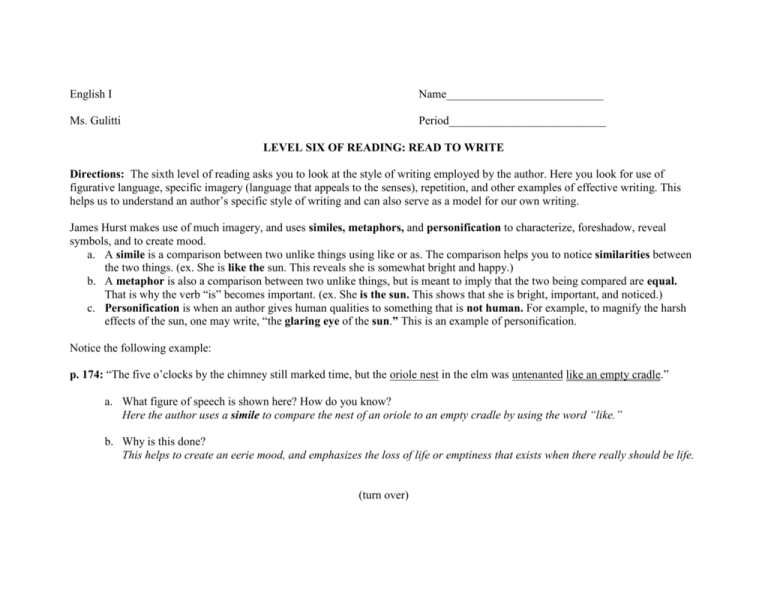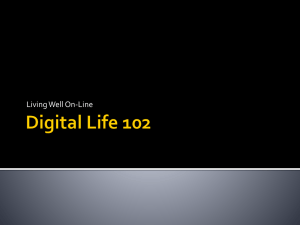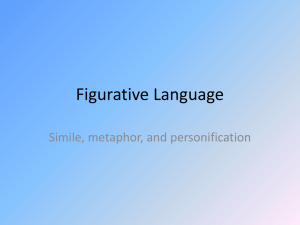English I - Jericho Public Schools
advertisement

English I Name___________________________ Ms. Gulitti Period___________________________ LEVEL SIX OF READING: READ TO WRITE Directions: The sixth level of reading asks you to look at the style of writing employed by the author. Here you look for use of figurative language, specific imagery (language that appeals to the senses), repetition, and other examples of effective writing. This helps us to understand an author’s specific style of writing and can also serve as a model for our own writing. James Hurst makes use of much imagery, and uses similes, metaphors, and personification to characterize, foreshadow, reveal symbols, and to create mood. a. A simile is a comparison between two unlike things using like or as. The comparison helps you to notice similarities between the two things. (ex. She is like the sun. This reveals she is somewhat bright and happy.) b. A metaphor is also a comparison between two unlike things, but is meant to imply that the two being compared are equal. That is why the verb “is” becomes important. (ex. She is the sun. This shows that she is bright, important, and noticed.) c. Personification is when an author gives human qualities to something that is not human. For example, to magnify the harsh effects of the sun, one may write, “the glaring eye of the sun.” This is an example of personification. Notice the following example: p. 174: “The five o’clocks by the chimney still marked time, but the oriole nest in the elm was untenanted like an empty cradle.” a. What figure of speech is shown here? How do you know? Here the author uses a simile to compare the nest of an oriole to an empty cradle by using the word “like.” b. Why is this done? This helps to create an eerie mood, and emphasizes the loss of life or emptiness that exists when there really should be life. (turn over) Part I: Now that you understand how to go about identifying similes, try the following on your own: 1. p. 174-175: “…where the white marquisette curtains billowed out in the afternoon sea breeze, rustling like palmetto fronds. a. Identify the simile and explain what is compared. b. Why might this be done? 2. Identify another simile found on the first column of page 175, underlining the clues given: Ex: “ a. Identify what is being compared: b. Explain the effect of this comparison. 3. p. 177: “I grabbed him in my arms and hugged him, our laughter pealing through the swamp like a ringing bell.” a. Identify the simile, and explain what is being compared. b. Explain what sense (touch, sight, sound, taste, or feeling) is further revealed through this simile. 4. Find two more examples of a simile using the following pages: 178, 179, and 181. Underline what is being compared. Page ___: “ Page ___: “ Part II: Now let’s practice looking for comparisons that are equal or metaphors. 1. p. 177: “…pride is a seed that bears two vines, life and death.” a. What two things are compared equally? What does this metaphor mean? 2. p. 180: “We decided to double our efforts, to make that last drive and reach our pot of gold.” a. How might the “pot of gold” serve as a metaphor? Explain. 3. p. 182: “Flocks of marsh crows flew by, heading inland to their roosting trees…” a. What might the flock of crows represent? How does this metaphor help to foreshadow later events? 4. The story ends with the following sentence: “…I lay there crying, sheltering my fallen scarlet ibis from the heresy of rain.” a. Here the metaphor is the “scarlet ibis.” What is the author comparing it to? Why? Part III: Lastly, let’s look at how the author personifies non-living things, and the effect it has on our reading experience. 1. p. 176: “I pulled the go-cart [to]…where the palmetto fronds whispered by the stream.” a. What is being personified? (How do you know?) What mood is created from this? 2. p. 179: “…the crops withered, curled up, then died under the thirsty sun.” a. Only one thing of nature is personified here—which one? What does this reveal about what has happened to the setting?






